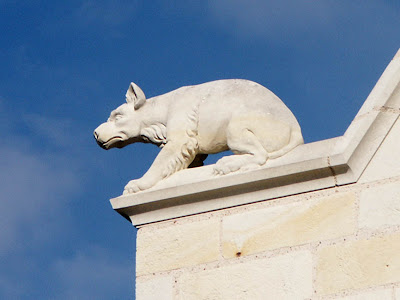The Touraine is riddled with underground passages. The limestone is quarried out for building, and many houses are built literally with the contents of their cellars. That is to say, the stone is excavated on site and the remaining cavity becomes the cellar. Or if the stone was being taken from the side of a cliff, a troglodyte dwelling, where a house façade one room deep might be tacked on to the front of the galleries, which became bedrooms and storage rooms.
Some underground passage systems were constructed for a somewhat more uncomfortable reason though. In many places there is also a network of much narrower tunnels, and where the quality of the stone for building is not the criteria for digging. The past residents of the Touraine have been subjected to many violent intrusions to their daily lives - feudal disputes, the rivalry between the English and French kings, the Wars of Religion.
Looking in to a side chamber off the main tunnel
at La Celle Guenand.

If you lived in a medieval town, you were protected by big strong walls with watchtowers and ditches, controlled by drawbridges, portcullis and postgates. Only a prolonged siege and sustained attack could deliver you into the hands of the enemy. If you lived in the countryside though, you couldn't defend your humble home, and had to resort to hiding in the woods or caves. Over time, many families or small communities dug tunnels specifically designed to protect people in times of trouble.
No one really knows when these tunnel systems first appeared, but they are mentioned in Roman accounts and it is possible they began in the Iron Age and were certainly used all through the Middle Ages and the Renaissance. During the Revolution they came into use again, becoming
cachette du prêtre and sheltering refactory priests who refused to give up their religion.
In modern times, I suppose the nearest equivalents are the trenches of the 1914-18 war or the bomb shelters of the Second World War.
The entrances are almost always difficult to find. It can be either a vertical shaft which you descend by hand / foot holds in the rock, or by a very narrow sloping gallery. The entrance itself was hidden under flat rocks and brush. The underground galleries have sudden right angle corners in order to make them easy to defend. You find deep slots which held the ends of great beams that could be inserted as barriers and almost always one or two 'cat flaps'. These were about 40cm in diameter, designed to entice an assaillant to stick his head through, only to find that he couldn't go any further and was stuck in a very dangerously undefended position.
A side chamber in the Celle Guenand system - I don't
think even a short medieval Frenchman would
have been able to stand up in here.

The most sophisticated tunnels had
niches de vedettes (openings in the walls allowing the beseiged to disappear sideways) and arrow slots in the walls which divided off 'rooms' from the main access. Through them you could watch the passageway and even pick off enemies who got too close.
The rooms were generally modest in size, about 4m x 5m, supported by massive pillars and aerated by 'ducts' through the 'vaulted' roof. There would also be benches out of rock, niches for oil lamps and storage pits for provisions. If you visit one you will be struck by the atmosphere of close humidity and shadow which pervades. They must have been horrible places to spend any time, but better than being slaughtered, raped or tortured on the surface.
Each family would have a place which they had prepared. As soon as the lookouts raised the alarm, church bells rang out to let the surrounding populace know they must come in from the fields and woods, and pack enough supplies for living underground for about 8-10 days. After that the danger should have passed, and everyone would go back to their cottages. If they were lucky, the marauding knights would not have pillaged all their remaining supplies, leaving them able to subsist for the rest of the year.These galleries were not totally impregnable though and there are a number of stories of 'total war' when women and children were deliberately asphixiated by smoke directed down the tunnels.
Except for a very few examples, furniture, weapons or utensils have not been found in these subterranean refuges. It is assumed they were kept in readiness as boltholes, but that no one was well off enough to leave weapons or household goods 'just in case', and after each use they were given a thorough clean out, ready for the next time.
It's not easy to estimate how many there were in the Touraine – many are now buried, destroyed, too well disguised or never recorded and therefore unknown now. One of the best preserved and most interesting is at
la Celle Guenand, and includes three storage pits. A few, such as the one at La Roche-Clermault, have graffiti, with drawings or dates (although these have been badly damaged by exposure to the air after the tunnel was opened up). The one at Pont-de-Ruan still has it's
chatière ('cat-flap'). There are others at Saint-Epain, Villaines, Cheillé and La Tour-Saint-Gelin.
Susan
 The Champagne region isn't the only one taking this step. For several years, individual wine makers have been choosing thinner bottles, but it is certainly easier if an entire AOC does it simultaneously.
The Champagne region isn't the only one taking this step. For several years, individual wine makers have been choosing thinner bottles, but it is certainly easier if an entire AOC does it simultaneously.


















































